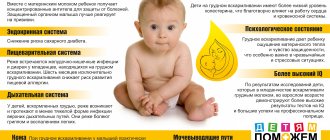Many mothers ask the question: “ How often to breastfeed a newborn ?” - as often as possible, depending on the child’s demand for food. Breastfeeding is a very important factor for the health of not only the baby, but also the mother. How long to breastfeed a baby is an important topic for nursing mothers. Some mothers consider it right to feed their child by the hour, while many nowadays believe it is necessary to feed on demand. Let's figure out how often to feed a newborn and how much to breastfeed.
How to breastfeed your baby correctly: starting breastfeeding
How breast milk matures. The mammary glands of a woman preparing for childbirth begin to rebuild during pregnancy.
Every pregnant woman notices this - the breasts “fill up”, significantly increase in size and become denser. In the first 2-3 days after the baby is born, the mammary gland “produces” not milk as such, but so-called colostrum - this is primary milk, which is quite different in composition and fat content from more mature milk.
Colostrum is extremely beneficial for a newborn baby and plays a key role in breastfeeding - it contains the highest concentration of proteins, microelements and fat-soluble vitamins, but is low in carbohydrates. This “cocktail” provides maximum immune protection for the baby, populates the intestines with primary microflora, nourishes the baby and is well absorbed.
It is very important to put the baby to the breast for the first time immediately after birth or, at a maximum, within the first 24 hours after birth.
Explains Irina Ryukhova, breastfeeding consultant for the AKEV association and author of the book “How to Give Your Baby Health. “Breastfeeding”: “The first attachment when breastfeeding is an acknowledgment of each other’s existence, the first acquaintance, it must take place at least in the first day after birth. In addition, colostrum is the natural and most beneficial nutrition for a newborn in the first days, which provides the baby with maximum protection from disease and growth. Finally, colostrum, due to its reduced fat content, is slightly weaker, which allows the baby’s intestines to be cleared of meconium (the first stool). In this way, the baby’s intestines get rid of the bilirubin accumulated in the meconium. This minimizes the risk of neonatal jaundice.”
Colostrum is produced in relatively small quantities - only about 20-30 ml per feeding. But, unlike mature milk, colostrum is produced constantly, and not in sessions. Nature conceived this mechanism so that the mother would put her baby to her breast as often as possible in the first days after birth. For what? In order for the baby to constantly suck on the breast, thereby irritating the nipple. The more active the nipple irritation occurs, the faster the production of mature milk will begin. And not only faster - but also more.
The most effective way to improve breast milk production is to constantly put your baby to the breast. Because it is nipple irritation that stimulates increased lactation like nothing else.
At the end of the third day, transitional milk begins to ripen in the breast, and after 2-3 weeks the mother begins to feed the newborn with full-fledged, mature milk. This is how breastfeeding develops at the initial stage.
“After a year there is nothing useful in milk”
The mother’s body does not know that today is the child’s birthday and does not begin to produce second-class fluid. Milk in both the second and third years of lactation contains all the proteins, fats, carbohydrates, vitamins, microelements, hormones, protective factors and much more that the child needs. During the involution of lactation, when breastfeeding ends naturally, breast milk approaches colostrum in composition. This is necessary in order to maximally protect the mother’s breasts and the baby’s health during the difficult period of weaning. The baby, having sucked milk for several months against the background of involution and received large amounts of immunoglobulins and other protective factors, which milk is rich in during involution, does not get sick after weaning for at least six months. And his mother, having weaned the baby, never faces problems such as mastitis, unlike a woman who stopped stable lactation untimely and illiterately. So milk after a year is useful for a child, just as breastfeeding is necessary for him. After a year, the baby is applied to the breast when he falls asleep and during night sleep, in the morning when he wakes up, he is applied during the day to fall asleep, asks for the breast when he wants to drink or drink other food, when he is upset, offended, needs consolation, runs up to his mother to suck when I missed her. With age, the need for breastfeeding decreases, because... the need for absolute maternal protection decreases. All children are very different. There are babies who, at 1.5-2 years old, can easily do without breasts, and there are children who need their mother’s breasts until they are 3-4 years old. The statement that breastfeeding for more than a year is harmful does not fit into the biological framework, if you look at a person as a mammal from the order of primates. Great apes nurse their young for approximately six periods equal to the length of pregnancy. In this case, the duration of breastfeeding for a person is 54 months, or 4.5 years. Some people may not like the comparison with monkeys, but biology must still be taken into account. In the first years of a child’s life, the foundations of his physical health are laid, the systems of his body are improved, and the main growth of the brain occurs in the first three years of a child’s life. Breast milk contains a huge number of components necessary for the development of the baby. These components are not in the most modern mixtures, nor in adult food, and never will be. As mentioned above, these are immune defense factors, tissue growth factors, hormones and biologically active substances, forms of vitamins and ratios of microelements that are optimal for absorption. The child needs to receive all this not only in the first year of life. There is no optimal duration of breastfeeding, because... There are no identical children and identical mothers. With proper organization of breastfeeding, the end of this process is somewhere between 1.5 and 4.5 years, and depends not on the opinion of doctors or close relatives and friends, but on the readiness for weaning of the baby and on the readiness of the mother herself for weaning from the chest. And nothing else.
“Dairy farm”: what determines the amount of milk during breastfeeding
If the baby suckles actively and vigorously, then, as a rule, during one feeding he almost completely empties one or both breasts. And in this case there is no need to express the remaining milk.
However, in reality, mothers often complain not about excess, but rather about a lack of milk during breastfeeding. It seems to them that the breast does not have time to fill up during the interval between feedings, it remains “empty”, and thus the baby does not finish eating. Many mothers at this moment turn to an assortment of artificial formulas and begin to actively supplement the baby with food “from a jar.” This is what breastfeeding experts do not recommend doing.
And they insist: applying to an empty breast is not only not pointless, but is also very useful for establishing breastfeeding. Since the lactation process begins in the woman’s cerebral cortex, a stimulus is needed to “supply” milk into the breast. Active sucking is such a stimulus. The baby “smacks” the empty breast, the brain immediately receives a signal that there is a “demand” for milk, and after some time the milk begins to flow into the breast.
If you want to establish full breastfeeding, do not stop putting your baby to your breast; on the contrary, do it as often as possible, even if at first the breasts are completely empty and attempts at lactation look like a complete mockery of a newborn baby.
Attempts to establish exclusive breastfeeding may well continue without harm to the baby’s health for 2-3 days. And only if, after 3 days, there are still obvious interruptions in the milk supply, and the baby is really not eating enough, risking his health and development - in this case, it is absolutely necessary to go to the store and buy a jar of formula for supplementary feeding.
The process of breastfeeding can take several days, but it is still worth putting up with the baby’s crying and weight loss for the sake of future full breastfeeding. In 3 days, nutritional deficiency will have almost no effect on the newborn baby, but in the end, your patience and perseverance can bring you a positive result: milk production will improve in full, and you will be able to fully breastfeed your baby without any “external supplements.”
When is enough
I’ll tell you a secret, 80% of women have problems with feeding. Yes, yes, some people have little milk, some have too much milk to the point of hard, stagnant lumps in the breast. But you and I went through childbirth, and it’s very painful, you remember, right? This means that they must fight for feeding until victory and feed as long as possible, up to 12-18 months. There are mothers who are breastfeeding fans who breastfeed until they are two years old and longer. There is no particular need for this, and over time there is not so much benefit in milk. Therefore, the benchmark is a year.
Requirement for others: a nursing mother must be loved, protected, cared for and cherished
There are quite a few fundamental differences between humans and other mammals. One of them is that all functions of the human body are “directed” by the cerebral cortex. That is why the mother’s lactation process is greatly influenced by her emotional state.
In other words: when an elephant or a mother whale is “sad,” or when they are scared, or when they are “on the run” or in captivity, the amount of milk in their udder does not change at all.
But when a human mother is sad or very tired, her milk “goes away,” until it completely disappears. That is why it is very important to surround a nursing woman with some adequate amount of attention and care - give her the opportunity to sleep between feedings, not burden her with household chores and simply make her happy: a woman who is breastfeeding a newborn baby is doubly pleasant and needs compliments, bouquets, kind words, etc. .P.
In addition, a nursing mother should not be restricted - most ideas about what a nursing mother can and cannot do are misconceptions.
Factors that positively affect lactation in the first month of a baby’s life:
- putting the baby to the breast as often as possible (active sucking and irritation of the nipple);
- emotional support for the mother, care for her;
- lack of stress;
- duration of the feeding “session” (the longer the baby sucks, the more milk will arrive the next time).
Does a newborn need water?
This issue causes a lot of controversy. Pediatricians believe that it is necessary to supplement a breastfed baby depending on the circumstances. If it is hot and stuffy outside or indoors, if the mother’s milk is very fatty, it will be better if you offer the baby regular drinking water.
If the child is bottle-fed, it is necessary to supplement him with water. The fact is that breast milk changes its fat content and nutritional value during one feeding, but formula is still food. Therefore, always offer your artificial baby some drinking baby water.
Breastfeeding styles
There are two main styles of breastfeeding:
- feeding on demand
- feeding according to the schedule
In the first case, the mother puts the baby to the breast “at the first squeak” of the child, regardless of how much time has passed since the last feeding. In the second, the baby is breastfed strictly by the hour - usually every three hours.
It’s rare that a mother chooses on her own which style of feeding to practice. Reality shows that most often the main determining factor is the child’s character.
If the baby is restless, noisy and active, the mother willy-nilly puts him to the breast endlessly and everywhere and becomes an “adept” of the feeding style on demand. If, on the contrary, the baby is very calm from birth, sleeps constantly and rarely cries, then the mother naturally begins to adhere to the “once every three hours” feeding regimen.
It will be useful for both mothers to know that:
If the child independently releases the breast nipple (and therefore he is full and does not want to eat anymore), then he may experience a physiological feeling of hunger no earlier than 2 hours later.
This means that if your baby, 30 minutes after feeding, screamed at the top of her lungs, then the reason for the screams is not hunger, but from something else: the skin is itching, on which diathesis has appeared, she is tormented by infant colic, she is simply “sick and scandalous.” mood". Anything but hunger.
Given this fact, modern pediatricians often suggest that mothers modify their feeding style by combining the principles of regimen and on-demand feeding into a free feeding technique. That is, the mother breastfeeds the baby on demand, but at the same time maintaining at least two-hour intervals between feedings. And while the baby is sleeping, they don’t wake him up to feed him - he’ll wake up and eat.
On the one hand, this style will protect you from overfeeding the baby (which is often the cause of prolonged colic), on the other hand, it will teach mother and baby to communicate not only through the breast (after all, you can calm a crying baby in other ways, in addition to “giving out” the treasured nipple). And finally, more or less adequate intervals between feedings will help the baby’s gastrointestinal tract system quickly establish the process of digesting food.
How often should I feed my newborn baby breast milk?
To answer the question of how to properly breastfeed a child, by the hour or on demand, imagine as if you were on a desert island, or in a cave many centuries ago.
What would you do then? Would you ask yourself how long does it take to breastfeed a baby or how many hours does it take to breastfeed a newborn? Would you take equal intervals between feedings? How often would you breastfeed? Would you feed your baby when he was hungry or wait for the sun to move from one point to another (you wouldn't have a clock)?
About expressing and storing breast milk
If you have chosen the method of breastfeeding on demand, then at the stage of lactation formation you don’t have to think about pumping. In conditions where the baby is constantly “hanging” on the chest, he simply will not allow either colostrum or the first mature milk to linger and stagnate in the chest.
It is necessary to express in three cases:
- If for some reason (for example, the baby was born premature and was sent to a hospital for growing up) you are separated from the child in the first days or weeks, but you plan to establish full breastfeeding in the future.
Breastfeeding consultant for the AKEV association Evgenia Trifonova: “If you understand that resuscitation can take weeks, then to maintain lactation you need to use a breast pump no later than 6 hours after birth. And then pump every 3 hours with a 5-hour break at night. Then there is a chance to continue breastfeeding the newborn."
- If you leave your baby with loved ones or a nanny, do not breastfeed, but you want your baby to eat breast milk.
- If a newborn eats less milk at one feeding than what has “accumulated” in your breast.
Regarding the last point, modern breastfeeding specialists and neonatologists often argue: there are supporters of pumping, and there are also opponents. The main argument in favor of pumping is the risk of lactation mastitis in the mother.
Observations of Dr. Komarovsky: “Nowadays, when doctors more and more often recommend that mothers not pump at all, the number of lactation mastitis has increased significantly.”
Lactation mastitis is an inflammation of the mammary gland during breastfeeding. In 87% of cases of lactation mastitis, the cause of the disease is lactostasis - in other words, stagnation of milk in the breast. If lactostasis continues for 3-4 days (for example, the mother has plenty of milk, the baby does not suck all of it, and the mother does not pump), then inflammation of the gland is almost inevitable, since stagnant milk is an ideal breeding ground for microbes.
Expressing is also necessary in order to ensure that the baby is fed in the absence of the mother (for example, the mother goes to work, and the grandmother or nanny feeds the baby with expressed milk). Properly expressed, frozen and thawed milk is no different in composition and benefits from the milk that the baby receives directly from the mother’s breast.
We will devote separate detailed material to how to express yourself correctly, why and when to do it, as well as how to properly freeze, store and defrost breast milk. Let us just remind you that expressed breast milk can be frozen (there are special bags and containers for freezing expressed milk) in the freezer for quite a long time. However, breast milk can only be thawed at room temperature and heated only in a steam bath.
“The milk will disappear quickly anyway”
Indeed, currently only 10-14% of children receive breast milk up to 3 months, the rest are already artificial. The reason for stopping breastfeeding so early is not that mothers do not want to breastfeed, or they have to go to work early, or they are hampered by poor environmental conditions. The reason is surprisingly simple and unpretentious: women simply do not know how to do it - breastfeed. Unfortunately, in modern society there is practically no one to learn them from. And most women don’t even think about the fact that breastfeeding needs to be learned. Meanwhile, breastfeeding is a woman’s art, the same as, for example, the ability to embroider, sew, knit, and cook deliciously. For some reason, it never occurs to anyone to expect a chic sweater from a woman who picks up knitting needles and yarn for the first time. But everyone believes that a woman who holds a newborn for the first time knows how to put it to her breast. She could have known this if, throughout her previous life, starting in early childhood, she had watched other women breastfeed and care for their babies, then the skills of breastfeeding and caring for an infant would have been known and understood by her. But even in such a situation, a woman giving birth for the first time would need practical help from a more experienced mother. It’s one thing to watch others feed, and another thing to feed yourself. In modern civilized society, the female art of breastfeeding has been lost, and the culture of motherhood has been lost. A young mother, even if she is ready to learn motherhood, may not find a woman in her environment who has experience in breastfeeding and caring for a baby. She will have many advisers who actually have no idea about the natural needs of the child, but are confident that they are right. I would like to recommend that before listening to advice, the mother should ask how long the adviser himself breastfed and whether he received positive emotions from it? Unfortunately, for most mothers now the main sources of authoritative information about breastfeeding are local pediatricians, most of whom do not have personal, successful experience in breastfeeding and the necessary theoretical knowledge, but have extensive experience in monitoring artificial feeding. And the advice from the constantly published and republished books of one male pediatrician who did not breastfeed anyone and did not even have children of his own is still popular. What about books? Unfortunately, in many modern books, the advice that is given on organizing breastfeeding and caring for an infant can be titled “What needs to be done to avoid more problems” or “How to lose milk faster.” Even if a mother has the best books about breastfeeding, where everything is explained correctly and in detail, she may not be able to breastfeed her own baby. Try, for the first time, taking knitting needles and threads, to knit something according to a book. It is unlikely that you will succeed in everything right away, but if you try for a long time, make mistakes, redo it again, someday you will really learn how to knit. But mother and newborn do not have the time and opportunity to learn by trial and error. By making mistakes, the mother gets a lack of milk, or nipple disease, or the child refuses to breastfeed, or all of this together. If at this moment there is no person next to her who can point out mistakes and show how to correct them, she will not be able to feed the child. So it turns out that now in our country approximately 5% of women feed their children successfully and for a long time. These are the lucky mothers: the baby immediately latched onto the breast correctly, and the mother, listening to her instincts and the needs of the baby, does not pay attention to the advice of “experienced” friends and relatives. Often such a mother doubts the correctness of her actions, because her child behaves completely differently from artificial children. And if she has the inner strength to resist persistent advice from outside, breastfeeding for her and her baby is quite successful. Unfortunately, very often, a woman who doubts herself, who actually had everything going well, begins to listen to incompetent advice and repeat the mistakes of others. Practical training in the necessary techniques, the transfer of personal, successful experience from one mother to another is the basis and key to successful breastfeeding. A mother who has received the necessary theoretical knowledge and trained in practical skills and techniques does not have problems with breastfeeding. She feeds for as long as her baby really needs from the point of view of physiology and psychology. In the civilized world, there are more and more organizations that are engaged in disseminating and maintaining knowledge about breastfeeding in society. These are not medical organizations. These are communities of mothers who have successful breastfeeding experience and are ready to share it with everyone who needs it. The experience of breastfeeding is passed on from mother to mother. It cannot be conveyed in any other way.
How long should you breastfeed your baby?
It is extremely important to ensure that the baby is breastfed in the first six months of his life - his health, his growth and development fundamentally depend on this.
Modern doctors around the world have agreed that if the mother has enough of her own milk, then only breastfeeding can be carried out for up to 6 months, which will fully cover the child’s needs for all necessary substances. That is, neither water nor complementary foods can be added to the baby’s diet.
The only exception is very hot climates, in which the risk of heatstroke in a young child increases dramatically. In this case, it is necessary to replenish the pathological losses of fluids in the baby’s body by supplementing it with water, and often even mineral water (that is, water with added salts) - we wrote more about this in the material about how to survive a hot summer with a small child.
And then, after you have celebrated the first six months of your baby’s life, everything regarding the duration of breastfeeding depends, first of all, on the desires and capabilities of the mother and the family as a whole.
At 6 months, it is recommended that the child be given the first complete complementary foods. However, it is highly advisable to continue breastfeeding. And then - the frequency and duration of breastfeeding gradually decreases, at the same time, the frequency and volume of complementary feeding increases accordingly.
If the mother has the opportunity (she still has active milk production) and desire, continued breastfeeding is welcomed by all pediatricians in the world, without exception. For example, WHO (World Health Organization) and UNICEF (United Nations Children's Fund) jointly recommend maintaining partial breastfeeding (that is, the child's diet consists mainly of other foods - vegetables, meat, cereals, dairy products, etc., but together Moreover, he receives a portion of mother’s milk every day) up to 2 years or more. Explaining the importance of this strategy by the fact that breastfeeding in children of any age significantly reduces the risk of various infections.
Reasoning logically, we can assume that for countries with a high level of medicine and a low level of spread of infectious diseases (Russia is one of these countries), the medical reason for long-term breastfeeding is not as relevant as for underdeveloped countries.
In modern pediatrics, there is an opinion that in developed countries with a high standard of living, breastfeeding a child after a year has not so much biological value as psychological value.
We know of cases where the duration of breastfeeding went beyond all conceivable limits and was perceived more as an anomaly than a favorable norm. But that's a different story...
In short. To put it as simply and clearly as possible, we repeat:
- It is strictly necessary (according to all biological laws) to breastfeed the child for the first six months;
- it is very desirable to extend breastfeeding - up to 1-1.5 years;
- at the discretion of the family and if the mother herself wishes, you can continue to breastfeed once or twice a day - for as long as you like.
To your health
How long should a baby suckle so as not to go hungry - instructions for young mothers
The World Health Organization and pediatricians believe that breast milk is the best and healthiest nutrition we can offer a baby.
Milk is a complete food. It is ideally adapted to the baby's body, contains more than 400 nutrients, an ideal balance of fats, proteins and mineral elements that enhance immunity, help with digestion, and promote proper growth.
Babies who receive breast milk during the first 6 months have fewer ear infections, are less likely to get colds, do not have bouts of diarrhea, and are less likely to go to the doctor with complaints.
The physical closeness of mother and child, breastfeeding, maternal breathing, and the warmth of the skin help the baby feel safe when eating. Children raised on breast milk have a healthy weight, grow well, and have a calm, balanced character. Breastfeeding prevents the development of sudden infant death syndrome, diabetes, obesity, and some types of cancer.
In this article, you will learn how long and how often you should breastfeed your baby and how long a baby should suckle at the breast to be fully satisfied during feeding. And also several other very important aspects.
What are the ABCs of breastfeeding?
• A = Absolutely comfortable conditions for the mother. This is an extremely important point. The mother's arms, head and neck should have additional support. Legs - placed on a stand. The body is in a relaxed position.
• B = Great patience. The baby needs to be fed until he is completely satisfied. You can’t rush or interrupt your meal. How long a baby should breastfeed during one feeding will be discussed below.
• B = Attention to the child's needs. You need to feed your baby when he feels hungry. This mode is called on-demand. In the first days of life, the baby requires from 8 to 12 feedings during the day. A hungry baby wakes up, begins to move his arms, makes various noises with his mouth, sticks out his tongue, purses his lips, as if he were sucking his mother’s breast. In this case, you should not wait for the child to start whining or crying, as this is a signal of severe hunger.
How long should you breastfeed your baby?
Pediatricians recommend feeding newborns exclusively with breast milk for the first 6 months. They also recommend adding breast milk to the diet after the baby begins to transition to solid food, until the end of the year of life and subsequent periods, if the mother can afford it.
How often should you breastfeed your baby?
A newborn baby should receive food 8-12 times a day during the first 30 days of life. If mommy feels that her baby is not getting enough, formula milk can be included in the diet. Breast milk is easier to digest than artificial milk formula, as it is ideally matched to the baby’s digestive system, is quickly digested and makes the baby feel hungry more often.
Frequent feedings stimulate milk production, especially in the first 7-14 days. Over the next 2 months, the breastfeeding schedule will gradually decrease and may amount to 7-9 breastfeeding per day. It is better to feed the baby on demand, when he is hungry, every 1.5-3 hours. The interval between meals should not be more than 4 hours, even at night.
How often and for how long you should feed your baby depends on the mother’s body, the baby’s appetite, and many other factors:
• volume and quality of mother's milk; • the rate at which milk enters the baby’s body; • correct position of the mother during meals; • moods of mother and child; • general situation.
How long should a baby breastfeed at one feeding?
The duration of feeding also depends on the age of the baby. Newborns require 20-40 minutes on each breast to receive food. But as the baby grows, he acquires the skills to eat quickly and over time receives nutrition within 5-10 minutes on one breast.
How often should you alternate breasts when feeding?
To maintain milk production in both breasts and prevent painful breast engorgement, it is important to alternate breasts when feeding. The feeding time is selected according to the baby’s appetite and the woman’s milk production characteristics. Some babies can be fed within 5 minutes on one breast, others may need 10-15 minutes on each breast.
Some experts recommend changing breasts in the middle of each feeding, and starting the next meal with the resting breast. Some women find this extremely helpful and keep a notepad with them to keep track of their feeding schedule. Others reject this path and feed the baby from one breast at a time.
In most cases, babies prefer to receive nutrition from both breasts. But there are some babies who like to be fed from only one breast. Which path mother and baby choose depends on personal preferences, but the method where two breasts are involved in nutrition is more convenient.
How can you tell if your baby is full?
Young mothers, especially those who have become mothers for the first time, are often concerned about whether the baby is full after feeding or not. A nursing mother can be calm if the child:
• remains satisfied after every meal and falls asleep sweetly; • produces approximately 4-6 wet diapers per day and has regular bowel movements; • sleeps well; • is attentive and calm while awake; • gains weight well.
If a child does not receive additional breast milk, he: • stays awake after feeding, continues to look for the mother's breast; • does not produce the required amount of wet diapers, has rare and scanty bowel movements; • fussy, cries a lot; • does not gain weight.
If you are concerned that your baby is not getting enough breast milk, call your doctor. Breastfeeding can be supplemented with formula milk.
Is burping after feeding normal or abnormal?
For breastfed babies, regurgitation of small amounts of food is normal. However, vomiting in large quantities should raise alarm bells. Vomiting after feeding is a deviation that requires medical attention.
Diapers as an indicator of proper nutrition?
Diapers are an excellent indicator of proper nutrition. The first milk a newborn receives is colostrum. It allows the baby to produce 1 to 2 wet diapers in the first 24 hours of life.
In the next 3-4 days after birth, the milk acquires a thinner consistency and allows for 4-5 wet diapers and greenish-yellow bowel movements once a day.
After 6-7 days of life, the baby should be producing more than 6 wet diapers per day with clear or very pale urine.
Fewer diapers indicate that the baby is not drinking enough. If yellow crystals appear on the surface of the diapers, you should immediately consult a doctor. Four or more yellow bowel movements during this period indicate proper nutrition of the newborn baby. Source - https://zhenskoe-mnenie.ru/themes/maternity/how-much-time-a-child-should-breastfeed-not-to-stay-hungry-instruction-for-young-mothers/
The benefits and reasons for night feedings: when children are for it, but mothers are not so much...
Most pediatricians and breastfeeding specialists rightly argue that for up to 6 months, night feedings are necessary and justified. Even if the baby sleeps peacefully until the morning and does not wake up with a “hungry cry”, he should still be woken up 1-2 times a night and put to the chest.
However, after reaching six months of age, it is quite reasonable to reduce the number of night feedings to once. This will significantly add strength and good mood to the mother, and will not in any way infringe on the child’s need for food.
How and when can you reduce night feedings? The following activities are very helpful:
- Later nightly bathing. After 11 pm, it is useful to bathe the baby in cool water, and then feed him tightly. This scenario helps the child fall asleep quickly and deeply and, as a rule, sleep soundly for the next 3-4 hours.
- Favorable microclimate. Create a cool and humid microclimate in the room where the child sleeps, which promotes sound and restful sleep. Parameters: air temperature - no more than 20 ° C, humidity - 50-70%.
Gradually, over time, night feedings can and should be “cancelled” altogether.
Lazy mother, no place to get milk
In pursuit of a beautiful figure after childbirth, many young and “green” mothers are in a hurry to go on a diet and exercise in the fitness room. For the sake of his figure, he sacrifices the most important thing that can happen to the baby now - breastfeeding! I have never understood such grief-stricken mothers and I am sure that you agree with me on this issue. Moreover, it has long been known: feeding is the best diet. Some mothers who feed only for show for two or three months, and then claim that they have run out of milk, also inspire little trust and respect. It's not a little milk, but a lot of laziness!
How to breastfeed correctly: summary
So, from the array of useful information, let’s try to squeeze out a brief rational grain:
- Breastfeeding is a type of feeding of newborns, infants and children up to 2 years of age and even older, which has no analogues in terms of benefits and value. Any comparisons between breastfeeding and artificial feeding are a priori advantageous in favor of the former.
- The surest and most effective way to establish breastfeeding is to put the baby to the breast as often as possible in the first days and weeks of a newborn’s life so that it actively stimulates the nipple.
- Breastfeeding in the first six months of a baby is a necessary norm, which provides the strongest possible protection for the child from diseases and fully covers all his nutritional needs.
- to supplement your baby with water or feed him any additional foods in the first six months. The exception is conditions in very hot climates, in which the baby needs to constantly replenish the water-salt balance.
- From 6 months to a year - breastfeeding (along with full complementary feeding) is highly desirable.
- The optimal style of feeding a baby up to one year is on demand, but with intervals between breastfeeding for at least 2 hours.
- After 1-1.5 years, the issue of breastfeeding is determined solely by the desire of the mother and baby.
- Expressed breast milk (if stored and thawed correctly) is just as healthy and nutritious as the milk in the breast.
How to wean your baby correctly
It doesn’t matter when a woman decides to stop breastfeeding, after 6 months or 2 years.
It is better that this does not coincide with events such as:
- illness or another vaccination;
- Mom going to work or visiting kindergarten;
- moving to a new place;
- hot time of year.
Weaning should be gradual. A sharp refusal can injure the child and harm the health of the mother. Even if you express your breasts, you can provoke congestion, leading to lactostasis, mastitis and even tumors. It is very important that during the entire time the child is weaned from the breast, the woman is supported by her family.
You can use the advice given by the famous pediatrician Komarovsky:
Mom needs to watch how much liquid she drinks. You should try to consume less than 600 ml per day (soups and cereals also count).- It is necessary to gradually reduce the number and duration of feedings, first removing one daily feeding, and then all. After this, you need to remove the night ones.
- You can express your breasts only if they are very full. If you try to express it after every feeding, this will lead to the opposite effect.
- A decrease in lactation is facilitated by the active lifestyle of a nursing mother and the refusal of foods that stimulate her.
All the recommendations that Komarovsky gives are aimed at reducing lactation and making the process of breastfeeding uninteresting for the child. How long a child can be breastfed is decided only by the nursing mother, focusing on the circumstances. One thing is important - the process should be smooth, not causing discomfort to either the baby or the woman. To minimize the risk of lactostasis, it is worth expressing your breasts until relief occurs.








